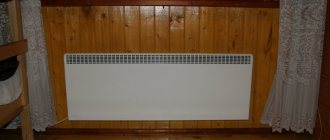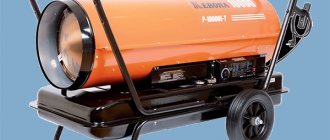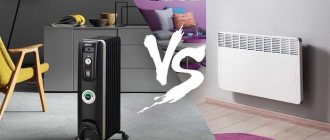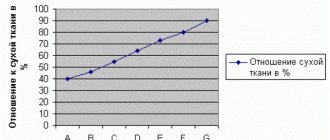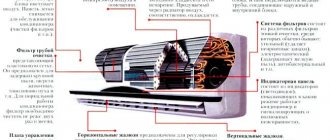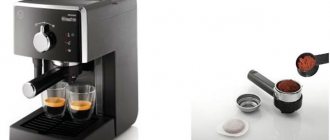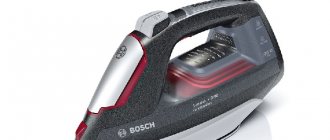At the same time, if earlier the choice was clearly in favor of oil radiators or small fan heaters, due to the lack of other safe alternatives, then recently convectors have become increasingly popular.
Now that there are options, many people begin to wonder before going to the store, which of these heaters is really the best? Is it worth spending money on a not-so-cheap convector or is it better to buy an old, time-tested oil pan?
Let's understand all the disadvantages and advantages of both devices.
Oil battery
This is perhaps the most classic type of heater. It works on the principle of heat transfer.
In this case, significant heat loss may occur.
After all, it first contains:
- heating element heats up inside
- then it heats up the oil
- only after this do the battery walls heat up
- and at the end, they transfer heat to the nearest space near the oil pan
Therefore, in order to warm up the entire room faster, it is initially placed almost in the center of the room. If you push it into a corner or lean it against the wall, you will wait a very long time for heat.
Moreover, the minimum distances from walls and from surrounding objects are usually regulated by the safety rules for placing such batteries.
If there is no air movement in the room, then until the heated volume of air space near the heater itself passes to the neighboring layers, and they, in turn, give off heat further along the chain, a very, very long time passes.
Of course, if you are sitting near the radiator itself, you will be hot. But as soon as you move to a sofa or chair, away from the radiator, the feeling of warmth suddenly disappears.
As a result, it turns out that a comfortable and uniform temperature in a relatively large room (living room, bedroom) cannot be achieved using an oil radiator.
Moreover, the bulk of the cold air flow is always located below. And the warm air from the radiator immediately rises, without in any way warming up the layer near the floor.
Therefore, even if you have such a heater in the room, you still have to constantly wear slippers.
The built-in mechanical thermostat is responsible for the question of the frequency of switching on and off oil batteries. Without such devices, it is generally not recommended to buy this type of heater.
So, due to the fact that the air near the battery itself is constantly warmed up much more than in the entire room, its operation error of 3 degrees is considered almost the norm. Although sometimes it reaches 5-7C.
What problem does this pose for you personally? And the trouble here is that the oil engine simply does not have time to adequately respond to the rate of change in temperature outside.
As a result, you experience constant discomfort. The room will either be very overheated, or it will be periodically cool, even with the battery constantly on.
And the point here is not the heat loss of the room, windows or walls. Namely, the incorrect operation of the heating device.
Operating principle of heaters
Before choosing a heating device for your home, you need to understand how a convector or oil heater functions.
The external device of the oil heater is a metal case, inside of which there is a container with mineral oil.
The operating principle of an oil heater is quite simple. After the device is put into operation, the heater is turned on, whose task is to increase the temperature of the oil. The oil heats the metal body, from which heat is transferred to the environment. This process is quite lengthy, but thanks to this, heat distribution occurs evenly throughout the room.
The best oil heaters are usually equipped with wheels to ensure greater mobility, as well as a thermostat to regulate the intensity of air heating. Oil heaters for the home are available in floor-mounted and wall-mounted versions. The wall-mounted option is recommended when there are small children or pets in the house.
Based on their location, household oil heaters are:
- Wall-mounted. They save space in the room, but require more time to warm up the air in the room. The whole trick is that warm air rises, the principle of operation of the heater is connected with this phenomenon; the lower the unit is located, the more efficient its operation. For this reason, oil heaters are most often mounted under windows;
- Floor or tabletop. The main advantage and distinctive feature of such devices is their high mobility. They can easily be moved to another room or removed when their work is no longer needed.
This heating device operates intermittently. When the temperature in the room reaches the set level, the built-in sensor turns off the heating element. When the temperature drops, the reverse process starts. This workflow allows you to save money on energy consumption.
A convector heater is no more complicated in design than an oil heater. It also has a heating element in its design that raises the air temperature. The name itself suggests that the operating principle of the device is based on convection, which is when cold air goes down and warm air, on the contrary, rises up. Thanks to this physical phenomenon, the room is heated.
What then is the difference between convectors and oil heaters? It’s simple, in a convector the heating element heats the air directly, in an oil heater the air is heated through the body of the structure. In the case of a convector, the housing does not heat up so much. This is the main factor when deciding what to buy – a convector or an oil heater.
Convectors differ in the type of energy consumed and are divided into electric, water and gas; each of them has its own characteristics, but in terms of power and design they have no serious differences. Most often you encounter electric convectors.
In addition, there are convectors that operate using infrared radiation. Typically, these models have a low level of efficiency, and because of this, it is recommended to use combination devices that quickly and evenly heat the air even in large rooms.
Electric convector
This unit operates on the principle of convection. That is, it gradually mixes layers of cold air in the room with hot ones. And all this happens without any fan.
The design of such heaters has a narrowed lower part and a wide upper part.
The heating element is located at the bottom. Moreover, there is nothing else inside the convector.
The air temperature in the “air pocket” of this battery before switching on is the same as in the entire room. But as soon as you plug it into a power outlet, in literally 1-2 minutes the heating element reaches its maximum temperature and warms up a “portion” of air inside the case.
According to the laws of physics, this heat rises upward, where it encounters built-in grilles or blinds on its way.
Colliding with them, warm air is redirected at a certain angle towards the floor, where it immediately mixes with the coldest layer in the entire room.
Moreover, please note that the shape of the air distribution louvers can have a significant impact on the entire operation of the device. For example, in those devices where the blinds are similar to the wings of butterflies, the air will always be hot both from above the convector and from below.
But in models with a fine mesh, the body at the top is usually very hot, and at the bottom it will be just warm.
Thus, in some models, the heated stream of air does not immediately rise to the ceiling, but is constantly mixed with cold streams, creating approximately the same temperature throughout the room.
In general, remember that the uniformity of heating of the room does not depend on the type of heater, but on the intensity of air mixing in it.
Moreover, convectors are produced that can not only mix warm and cold air, but also purify it. The presence of all kinds of filters helps in this - anti-dust, carbon, biologically active with vitamin C, etc.
But since these are consumables, sooner or later they have to be replaced. Imagine that in the future such filters will be discontinued? What will you do?
Therefore, you shouldn’t bother too much here, and it’s easier and cheaper to choose models without fancy cleaners, ionizers, sterilizers, etc.
Temperature control and power consumption
Convectors, like oil batteries, have their own mechanical thermostat. However, its error due to the correct mixing of cold and warm flows near the heater itself is minimal and amounts to less than 1 degree.
Due to more accurate operation of the thermostat, the continuous operation time of the convector is also adjusted. This results in greater energy efficiency and lower power consumption.
At the same time, the air in the room warms up more evenly. You won’t have too much of a temperature difference in different corners, even if you don’t place it in the middle of the room, but hang it close to some wall.
If you don’t really trust all these stories about efficiency, just compare the energy efficiency or energy saving class of oil heaters and convectors. On stamps from leading brands, it is usually indicated.
So, even the best oil coolers have the worst class - D. And for convectors, it is usually no lower - A. There are some models with the highest class - A+++.
In some European countries, it is even officially prohibited to sell and plug in such electrical appliances with an energy efficiency class below A.
Convector safety and maximum heating
Another advantage is the heating temperature of the walls. The body of the convector itself never heats up to such temperatures as oil radiators.
You don’t have to constantly monitor and worry about your children so that they don’t accidentally get burned.
Well, if the thermostat accidentally breaks down in the oil pan, this can lead to overheating of its walls and the formation of microcracks. If these cracks are in the upper part, then the oil will gradually begin to evaporate in the room. And you will breathe all this every day.
If the crack is from below, then the liquid will gradually flow out of the device. And even then, this type of breakdown can be considered a happy accident.
When no such crack has formed, the battery simply bursts due to internal pressure, and boiling oil begins to gushing out in all directions.
Of course, branded oil radiators (Electrolux, Zanussi, Ballu) use non-flammable synthetic oil. But this will not make it any easier for you.
With convectors you are freed from such problems once and for all. The maximum that can happen is that the heater will consume more energy than usual.
Comparison of convectors and oil heaters
So, let's see how a convector differs from an oil radiator. Convectors have a simpler and safer design. They do not contain any coolant; they heat the air directly, without intermediaries. In addition, mineral oil can leak due to cabinet corrosion - it will flood floors, damage carpets and can cause burns . It should also be noted that the presence of oil significantly increases the time the device reaches full power.
Another difference between a convector and an oil radiator is its efficiency in terms of energy consumption. Depending on the model, it consumes up to 15-25% less than the oil model with the same area of heated premises. Electric heating is expensive, so we recommend paying special attention to this property of convectors.
We recommend using oil convectors as auxiliary equipment - to help convectors or water heating. This is how most consumers use them.
The body of the electric convector does not heat up to high temperatures and is safe even for children.
Another difference between a convector and an oil heater is the temperature of the housing. Convectors are made so that they heat the air, but remain as cold as possible. Usually the temperature of their cases is +60-65 degrees, and the back wall remains cool. Thanks to this, convectors can be installed in any room without much danger, for example, in children's rooms.
Oil heaters are hotter because they heat the air through their housing. If you set the maximum power and maximum temperature, you can get burned on the metal. And if an adult can still survive such a burn (as a rule, its temperature does not exceed +100 degrees), then for small children it will be more noticeable.
Oil heaters equipped with special plastic protection have the greatest safety. Such protection allows air masses to pass through without problems, but prevents burns. However, you have to pay for this option.
There are practically no differences in heating speed between oil heaters and convectors. Oil models may seem slower, but convectors are approximately the same slow. The difference may be possible to measure, but it will be insignificant. Therefore, it is still not worth considering this as a factor of choice. If you want to experience faster heating, we recommend choosing equipment equipped with fans for forced convection.
An important factor determining which is better, oil radiators or convectors, is the service life of the electrical appliances presented. Convectors are more durable, since apart from air heating elements they contain nothing - no coolant, no mineral oil . The devices last a very long time, showing a high level of reliability. Oil heaters are prone to breakdowns - they often start to leak, and it is easier to throw out a faulty heater than to repair it.
If the breakdown of the oil cooler is not associated with an oil leak, then a competent specialist will be able to bring it back to life.
As for the combustion of oxygen and other environmental factors, nothing of the kind is observed in either equipment. Convectors and oil heaters do not burn oxygen, unlike fan heaters and other devices with open heating elements. True, they can dry out the air somewhat, which is compensated for by using a humidifier or a container of water installed next to the equipment.
Some consumers with allergies criticize convectors for raising dust. We recommend that such people take a closer look at devices with built-in dust filters. As for oil heaters, they even win here - the dust from them can be easily wiped off with a damp cloth.
Convector control units - which one is better
And for greater efficiency, convectors can be equipped with:
- electronic control unit
With it, the heater becomes up to 40% more economical than an oil heater.
- or inverter
Cost efficiency reaches 70%. For greater clarity, imagine a car driving uniformly along a highway at the same speed. This is an inverter.
Without it, the heater will resemble a car moving through traffic jams in the city. Who do you think will have more fuel consumption for the same mileage? It's the same with convectors.
The point of inverter units is that the heater “understands” what the general temperature is in the room. Correlates it with the specified parameters and, based on these data, regulates the power of the work.
That is, the device does not operate at maximum power all the time, as is the case with the classic mechanical version. Here, heating first occurs to a given temperature, and then to maintain it, the maximum power is not used at all.
This is precisely what inverter technology is all about, due to which the efficiency of such models is achieved.
Here's supporting documentation and real-world test data for all of the above claims. All with signatures, seals, etc.
Convector tests and conclusion
With such units, you can regulate the temperature in the room with an accuracy of tenths of a degree.
Another advantage of convectors is the versatility of their placement. Most of them have wheels for moving around different rooms of the apartment.
So is the stationary type of fastening. With its help, the convector is placed on any wall in the form of a battery.
However, be careful about one thing. Some people attach foil or other shiny reflective material to the wall behind the heater body. This should supposedly help reflect heat and improve heating.
However, if your model has a temperature sensor at the top, then this foil will cause it to overheat. Accordingly, the convector will not work correctly and will not heat the room a little.
For devices with a bottom-mounted sensor, such a reflective surface has little effect on its operation.
But no one hangs oil batteries on the wall at all. In the summer, they constantly get in the way, or take up extra space on the balcony or in the closet.
So it turns out that if you place it in the same conditions - the same room area, the same initial temperature, the same operating time, two heating devices, then the convector will ultimately outperform the oil battery in all respects.
Here are real reviews from users who switched to fully heating their homes with convectors.
How a convector works and works
Externally, it is very easy to distinguish a convector from an oil radiator. While the latter looks like an “accordion on legs,” the former has a flat, smooth body with slots at the top and bottom. The main difference between these devices is the method of heating the room. The radiator first heats the oil, and the convector heats the air masses directly.
The operating principle of the convector is based on the physical properties of cold and hot air. The second, as you know, is easier. In the hollow body of the convector there is only a heating element (coil) and a temperature sensor. Cold air enters the convector through slots located at the bottom of the device. Then the air masses, heated by the heating element, naturally exit through the holes located in the upper part of the housing. And their place is again taken by cold air, the process repeats.
Each convector heating device is equipped with a temperature sensor, which turns the device on and off depending on whether the air in the room has reached the set temperature. This is very convenient since there is no need to monitor the device. Automation independently maintains a comfortable temperature in the room.
Almost all convector models have two placement methods.
They can be hung on the wall or mounted on special legs and placed in a convenient place on the floor. See also -
Choosing the best electric convector for your home

